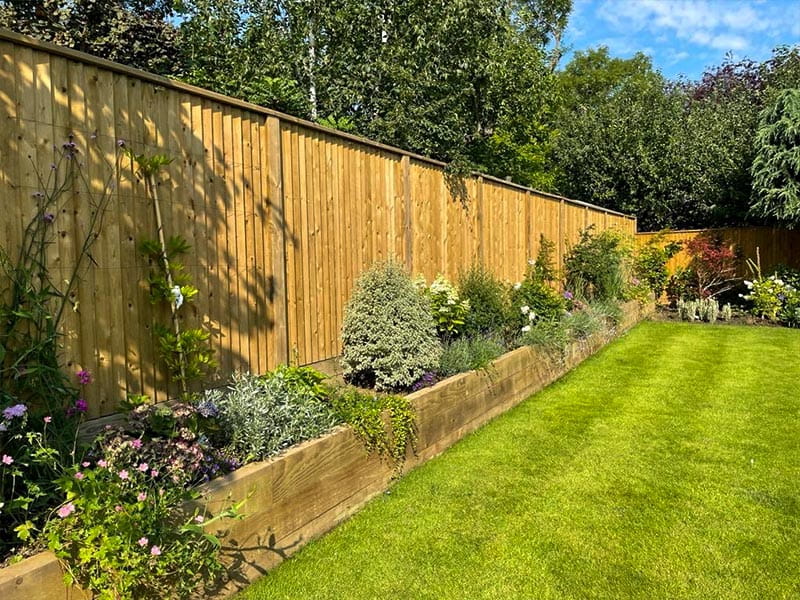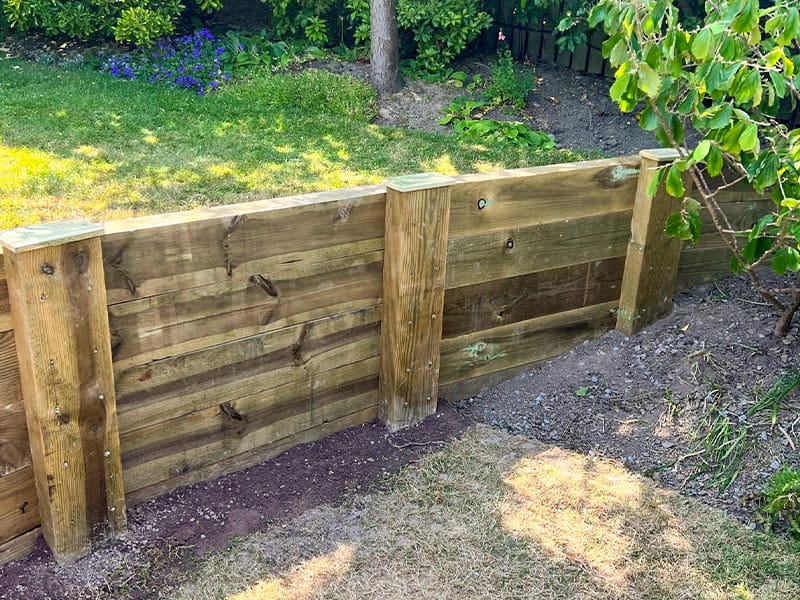23/11/2023 02:17 PM
Timber sleepers are a common material used to create a garden retaining wall.
Timber sleepers are a sustainable alternative to bricks or concrete that offer a natural aesthetic and take less time to install compared to bricks or concrete. Installed horizontally in a brick laying pattern or vertically, retaining walls provide a multitude of benefits.
The 4 main functions of a retaining wall made with sleepers:
- To create functional levels in a sloping garden
Sloping gardens often have minimal functional space. By levelling the ground and using retaining walls to hold the soil, you can create useable level ground. - Soil retention
Excess soil can be kept in place laterally between different ground levels that would not naturally stay stable. - Decoration
Not only do retaining walls create functional areas out of sloping terrain, but their design can also complement and make a focal feature in a garden. Utilising the higher ground, large, raised beds can be made, or the sleepers could be laid to create a seating area. The possibilities are endless. - Support for natural slopes
Retaining walls have great functionality to help naturally sloping ground. Sloping ground can move and change gradients over time, which does not bode well for gardens. Ground can become waterlogged and muddy, which affects the integrity of the ground. A retaining wall offers support to hold it in place.

Can you use sleepers for a retaining wall?
Timber sleepers are a great material to use for retaining walls. They offer a sustainable alternative to concrete or brick and are often much more affordable, requiring less labour to install. Ensure the timber used is suitable for in-ground conditions with quality timber treatment to guarantee longevity.
How to install a retaining wall
Full installation instructions of how to install a retaining wall correctly can be found using the button below.
how to install a retaining wall

The most effective technique to build a stable retaining wall is a solid foundation. Gravel should be added to ensure there is enough drainage, with a porous membrane to prevent earth sliding into the channel.
Wooden treated sleepers should be laid in a pattern similar to bricklaying. Taller walls may require vertical timbers installed behind or in front to offer additional support.
Larger retaining walls hold a lot of weight behind them, so the integrity of the installation is paramount. Speaking with a skilled installer is advised if undertaking the job yourself. Consider using one of our Approved Installers.

How long will sleepers last as a retaining wall?
Depending on the material chosen and the type of sleeper used, as well as how well they are installed and the conditions, this can vary; premium, well treated timber sleepers can last more than 25 years.
Timber sleepers that are specifically treated for in-ground contact and come backed with long guarantees will potentially outlast this estimate. Still, it is worth noting that not all treatment methods are equally effective. Cheap timber sleepers that are only surface or dip-treated will usually fail much sooner than pressure-treated sleepers, where the preservative penetrates deep into the centre of the wood, providing longer-lasting effects.

We advise not to cut any timber that will be in contact with the ground. Therefore, we recommend that this is only done where necessary and that cut ends are always treated afterwards to avoid exposure to rot or insect attack.
When installing a retaining wall, it is important to allow for adequate drainage, so that the sleepers are not saturated in water. This is usually performed by installing coarse gravel behind the retaining wall and a perforated drain. View our installation instructions above.
Can I lay sleepers on soil?
We suggest using gravel or sand to provide drainage and a level surface when laying sleepers directly on soil. When creating taller retaining walls using a large number of sleepers, a solid foundation is integral for the overall stability. As mentioned before, drainage is crucial, so gravel is necessary, as waterlogged soil can become unstable and cause water to pool in some conditions.

Retaining wall drainage
Using gravel and a permeable/porous membrane like landscaping fabric or a weed membrane that allows for adequate drainage will aid the removal of excess water. For larger structures, a drainage pipe should also be added to prevent pooling water.
Uses for retaining walls with sleepers
A retaining wall is not only for function, it can also create a focal point and a garden feature. From flower beds to seating areas, the possibilities of retaining walls made from sleepers are countless.

You can stack sleepers on their broad or thin side or even vertically to achieve different landscaping results, even combining them with other textures such as gravel and or paving to contrast.
Vertical retaining walls with sleepers
Installing sleepers vertically to create low retaining walls is a popular technique used by garden designers, especially to create freestanding features and structures such as curved walls with stepped or staggered tops.
When installing sleepers vertically, it is sometimes necessary to dig a trench to place timbers in, or depending on the length of the timbers, they may have to be cut shorter. In this case, the cut end should the end out of the ground and then treated with Jakcure® cut treatment preservative. Please follow our guarantee guidelines for more details.

One of our Approved Installers used timber sleepers to help transform a steep garden into a multi-functional family garden. Read more in our blog - Kent Based Fencing Installer Transforms Steep Garden
Jakwall, the contemporary alternative to sleepers
Jakwall® contemporary landscape sleepers are a versatile addition to our landscaping timber range, available in two distinct styles. One version features a brick-like textured front with a softer, more refined appearance, complemented by chamfered edges. The other version maintains the same clean, modern aesthetic but without the textured grooves on the front.
The example below showcases Jakwall being utilised to create a raised flower bed, seamlessly integrated alongside a pathway.

Another example below highlights Jakwall ungrooved contemporary sleepers supporting a high raised area. This popular design offers a sleek, low-profile alternative to traditional sleepers, enhanced by chamfered edges for a refined finish.

Landscaping timbers are a great tool for retaining walls, and it is worth investing in quality timber to ensure longevity.
Please also remember to view our installation instructions for a complete guide on correctly installing retaining walls with sleepers with the link below.
Jakwall® timber retaining wall
RELATED CUSTOMER PROJECTS AND CONTENT
Maureen Vinall’s Faversham garden makeover, inspired by Jacksons' show gardens, features Jakwall landscape timbers, a wooden pergola, and raised beds. This stunning redesign transformed a small garden into a spacious, functional, and visually appealing haven:
Transforming Outdoor Spaces with Jakwall and Pergola
In this blog, we explore how to transform an unsightly retaining wall into a stylish, low-maintenance feature with Jakwall Timber Sleepers. Discover how Jakwall offers a modern alternative to traditional solutions, creating a functional and attractive space for pets and socialising:
Creating a Stylish Retaining Wall with Jakwall Timber Sleepers
In this blog, discover how Cowen Landscapes turned a steep, unusable garden in Bearsted, Kent, into a beautiful, functional family space. Using retaining walls, timber sleepers, and raised beds, they created a garden that’s both practical and stunning:
Transforming a Steep Garden with Retaining Walls and Sleepers